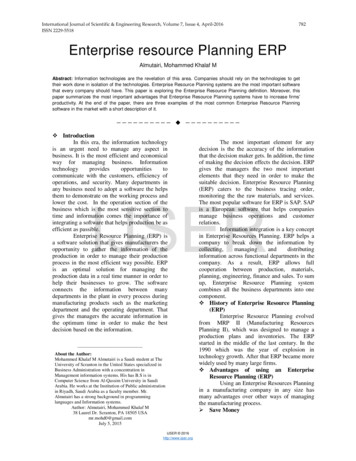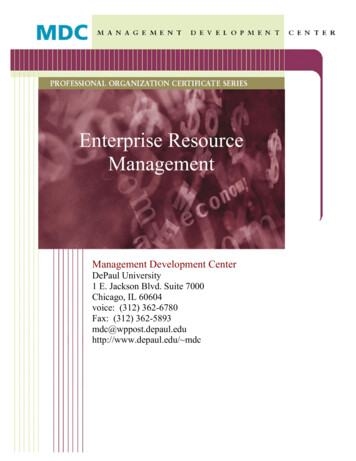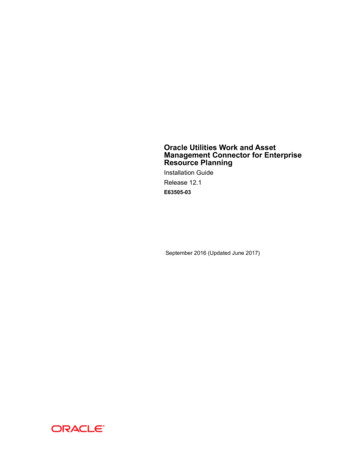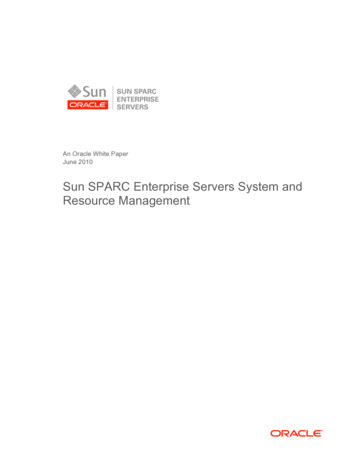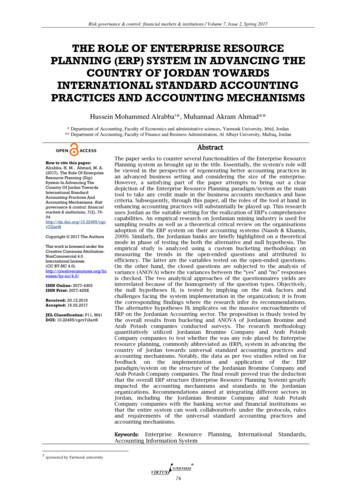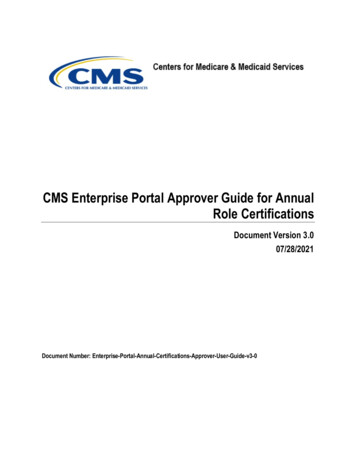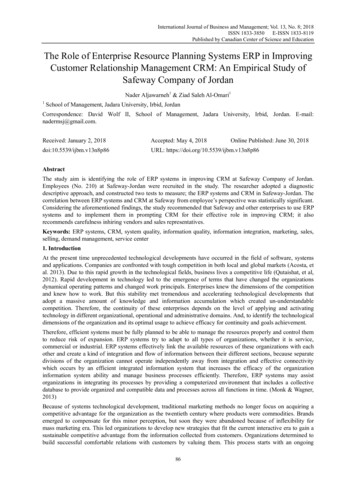
Transcription
International Journal of Business and Management; Vol. 13, No. 8; 2018ISSN 1833-3850E-ISSN 1833-8119Published by Canadian Center of Science and EducationThe Role of Enterprise Resource Planning Systems ERP in ImprovingCustomer Relationship Management CRM: An Empirical Study ofSafeway Company of JordanNader Aljawarneh1 & Ziad Saleh Al-Omari11School of Management, Jadara University, Irbid, JordanCorrespondence: David Wolf II, School of Management, Jadara University, Irbid, Jordan. E-mail:nadermsj@gmail.com.Received: January 2, 2018Accepted: May 4, 2018Online Published: June 30, 2018doi:10.5539/ijbm.v13n8p86URL: https://doi.org/10.5539/ijbm.v13n8p86AbstractThe study aim is identifying the role of ERP systems in improving CRM at Safeway Company of Jordan.Employees (No. 210) at Safeway-Jordan were recruited in the study. The researcher adopted a diagnosticdescriptive approach, and constructed two tests to measure; the ERP systems and CRM in Safeway-Jordan. Thecorrelation between ERP systems and CRM at Safeway from employee’s perspective was statistically significant.Considering the aforementioned findings, the study recommended that Safeway and other enterprises to use ERPsystems and to implement them in prompting CRM for their effective role in improving CRM; it alsorecommends carefulness inhiring vendors and sales representatives.Keywords: ERP systems, CRM, system quality, information quality, information integration, marketing, sales,selling, demand management, service center1. IntroductionAt the present time unprecedented technological developments have occurred in the field of software, systemsand applications. Companies are confronted with tough competition in both local and global markets (Acosta, etal. 2013). Due to this rapid growth in the technological fields, business lives a competitive life (Qutaishat, et al,2012). Rapid development in technology led to the emergence of terms that have changed the organizationsdynamical operating patterns and changed work principals. Enterprises knew the dimensions of the competitionand knew how to work. But this stability met tremendous and accelerating technological developments thatadopt a massive amount of knowledge and information accumulation which created un-understandablecompetition. Therefore, the continuity of these enterprises depends on the level of applying and activatingtechnology in different organizational, operational and administrative domains. And, to identify the technologicaldimensions of the organization and its optimal usage to achieve efficacy for continuity and goals achievement.Therefore, efficient systems must be fully planned to be able to manage the resources properly and control themto reduce risk of expansion. ERP systems try to adapt to all types of organizations, whether it is service,commercial or industrial. ERP systems effectively link the available resources of these organizations with eachother and create a kind of integration and flow of information between their different sections, because separatedivisions of the organization cannot operate independently away from integration and effective connectivitywhich occurs by an efficient integrated information system that increases the efficacy of the organizationinformation system ability and manage business processes efficiently. Therefore, ERP systems may assistorganizations in integrating its processes by providing a computerized environment that includes a collectivedatabase to provide organized and compatible data and processes across all functions in time. (Monk & Wagner,2013)Because of systems technological development, traditional marketing methods no longer focus on acquiring acompetitive advantage for the organization as the twentieth century where products were commodities. Brandsemerged to compensate for this minor perception, but soon they were abandoned because of inflexibility formass marketing era. This led organizations to develop new strategies that fit the current interactive era to gain asustainable competitive advantage from the information collected from customers. Organizations determined tobuild successful comfortable relations with customers by valuing them. This process starts with an ongoing86
ijbm.ccsenet.orgInternational Journal of Business and ManagementVol. 13, No. 8; 2018strategy that transforms organization focus from traditional selling and manufacture to the customer with anincrease in revenues and profits on current and long terms (Peppers & Rogers, 2011).The ability to communicate with customers constantly using a variety of different means for that reason istermed “customer relationship management (CRM)”; it provides the foundations that help organizations todevelop and enhance customer’s services and attract them. The increased competition in business worldprovoked companies to take interest in understanding customers and to interact with them for the reason oftaking opportunities and facing challenges (Kostojohn et al., 2011).Companies seek to develop and enhance good relations with customers, good communication results indevelopment, sustainability, maintenance of the new competitiveness level the company reaches and to achieveuniqueness in performance. Customers are considered the engine and effective axe of all companies; CRM aimsto persuade customers to repeat buying services by using best practices and methods to enhance customer loyaltyand maintain it. Customer’s services are rapidly changing, competition between companies is fierce,technological developments are growing and companies are looking for globalism, hence the Jordan Investmentand Supply Company (Safeway) needs effective systems to manage procedures, workflow, control variousprocesses, share data and information of different functional activities and reduce stocks waste to achievecompetitiveness, sustainability, reduce costs, increase performance efficacy and manage customer’s needseffectively.Systems that change the nature of the relationship with customers include ERP systems. The problem of thestudy stems from the need to recognize the role of ERP systems and its dimensions (System Quality, InformationQuality and Information Integration) in enhancing CRM and its dimensions (marketing, selling, demandmanagement and service center) in Jordan Investment and Supply Company (Safeway), the study problem isexplained by answering the study questions.1.1 The Study QuestionsThe current study attempts to answer the main question of “what is the role of ERP systems in enhancing CRMat Jordan Investment and Supply Company (Safeway)?” several sub questions emerge from the main question:1.What is the level of using ERP systems at Jordan Investment and Supply Company (Safeway)?2.What is the level of applying CRM at Jordan Investment and Supply Company (Safeway)?3. What is the effect of ERP systems dimensions (System Quality, Information Quality and InformationIntegration) in enhancing CRM and its dimensions (marketing, selling, demanding management and servicecenter) in Jordan Investment and Supply Company (Safeway)?1.3 Importance of the StudyThe importance of the subject studied gives importance to the study. Customer’s volume is of the main factors ofsuccess for any organization. Companies may plane strategies to manage customers relationships and to enhancethem by ERP systems, the study is hoped to be a corner stone for further studies and to:1.Guide researchers in ERP systems with the results and recommendations;2. Help Jordan Investment and Supply Company (Safeway) managers in developing the relationship withcustomers by ERP systems;3.Clarifies the effective role of the ERP systems in supporting CRM;4. Assist organizations that are not using ERP systems to realize the importance of integration between ERPsystems and CRM.1.4 The Study ObjectivesThe study aims to recognize: the level of using ERP systems in CRM, the level of applying CRM and the roleERP systems in enhancing CRM in Jordan Investment and Supply Company (Safeway).1.5 The Study ModelThe study was based on two variables: the independent variable of ERP systems and its dimensions (systemquality, information quality and information integration), and the dependent variable of CRM and its dimensions(marketing, selling, demand management and service center), the following diagram illustrates the model.87
ijbm.ccsenet.orgInternational Journal of Business and ManagementIndependent variableDependent variableERP systems:CRM:System QualityMarketingInformation QualitySellingInformation IntegrationDemand managementVol. 13, No. 8; 2018Service center2. Theoretical Framework2.1 Enterprise Resource Planning SystemsBecause of business environment complexity, enterprises realized that the correct information at the right timehelps build business relationships. Enterprise management needs an effective information system to improveservices and reduce costs, thus increase competitiveness (Simunovic et al., 2013). Business environmentfluctuations require ERP systems that quickly adjust its applications to the changes in the organization structureand standardized processes (Sarno et al., 2015) to link processes through a formal system and through thesupport tools to make decisions and achieve goals (Sheldon, 2005) by an integrated single Enterprise System (ES)(Laudon & Laudon, 2012).2.2 The Concept of ERP SystemsComputers were introduced to the business environment in the twentieth century, information systems were usedin a limited range to serve one task such as accountancy or sales, hence organizations needed different systems tomeet their various functions. This process led to repeated data and focus on administration without sharing data.In mid-nineties organizations started constructing ERP systems to computerize unite and integrate businessprocesses to reach effective planning and control. RP systems offered employees from all administrative levelsthe ability to search through a variety of systems to find needed information and to use it from the same sourceof data (Bradford, 2014).Matenda and Ogao (2013) said that applying ERP systems is different than applying traditional informationsystems; because of the integrated nature of ERP systems that cause radical changes on the work flow,organization structure and the way employees perform their duties.Jeph (2013) defined information systems as a set of different components including devices, programs,communication infrastructure, individuals’ organization to enhance planning, control, organization and decisiontaking.ERP systems are software suited to business management functions that include purchasing, selling, stockmanagement, human resources, financial resources and logistic services that provide a unified database for theorganization to integrate and correlate with other organizations by a series of business procedures (Tsai & Chou,2015). This integration and correlation helps create a transparent information environment that enables seniormanagements to build informed expectations based on real-time data that describe the organization processes andthe economy state (Tian & Xu, 2015).Yen, Idrus and Yousef (2014) defined ERP systems as a set of software that provides an integrated data transferprocess between different functional areas for unifying them in one system environment, coordinating businessprocesses, enhancing administrative structure between functional areas to ensure an integrated informationsystem that includes systems processes within the organization including an organized database to enhance theorganization stability, provide data storage which is easy to access and use in the stock control process, buying,selling, billing and personal loans accounting (Murthy, 2008).Therefore, ERP systems work as the spine that correlate administrative thinking with marketing, buying, selling,manufacturing, planning ability and customer services to take a decision (Sheldon, 2005). Scholars define ERPsystems as the best software of information exchange and synchronization of it between functional areas tointegrate in a unified database to lead business effectively.The main reason of ERP systems large number in the market is attributed to ERP systems quality, information88
ijbm.ccsenet.orgInternational Journal of Business and ManagementVol. 13, No. 8; 2018integration and quality. The quality represents the systems’ ability to achieve and meet what it was designed forwith the lowest cost, the ability to perform the work in the right manner with the least time and effort, indicatingexcellence. Quality has many definitions that indicate excellence, match of specifications, and value for moneyand the flexibility extent in usage. ERP systems are the ultimate measure of products design and processengineering to ensure the quality of data to all functional divisions in manufacturing enterprises to recognize therepeated processes, to analyze main methods of problems, to enhance manufacturing methods continuously(Parthasarthy, 2007).2.3 System QualityKhlif and Jallouli, (2014) referred to system quality as the critical curve of the enterprise that maximizesrevenues of investments for the need of users to manage technology and adopt systems. It is the ideal system thathas infinite accuracy, uses its resources efficiently, is not aware of the external changes and is rebuilding indifferent applications. By implementing the system efficacy and accuracy limitations are found, the quality of thesystem is determined by several quality indicators some of which are: accuracy, strength and durability inholding secondary inputs, flexibility, efficacy and secondary outputs. (Veldhoven & Roermund, 2011)2.4 Information QualityThe organizations motivation to understand and enhance the information quality and data is important.Nowadayslots of organizations lost face to face communication with customers, suppliers and public organizational partiesand employees, the basic correlation with those individuals and entities occur by the information circulated whileexchanging goods and services. Verifying the data from personal communication in the supply chain may behindered, which leads to problems in trying to understand enterprises because the data includes organizationalcontacts, so costs related to the information quality are hard to measure because it includes tangible andintangible components (Wang, et al, 2005). Thus, information quality should include five properties: accuracy,comprehensiveness, reliability, content and availability in a timely manner (Tsaia et al., 2012).2.5 Information IntegrationWong et al. (2011) mentioned that information integration means sharing information of the enterpriseinfrastructure to support information exchange and coordinate between business functions and businessassociates, provide information integration for standardized organizations and digital information exchangethrough organization business activities to enable them to compete more effectively in the markets and to enablebusiness associates of meeting their functional needs to enhance mutual performance. The goal of ERP systemsis to achieve a high degree of integration to form widely spread information systems that work as aninfrastructure of information integration in the basic business processes. If all these functions are easilyintegrated via a joint data base, efforts will not be lost in interpretation of the disorganized information within theorganization. High integration levels enable any salesman to determine the best delivery date, feel confidence ofdemand information because it is not going to be lost, and know that sales communication expenses will beallocated to the correct location in the sales groups to be handled and paid quickly. (Murthy, 2008)2.6 The Concept of CRMThe concept of CRM emerged because of the emergence of relationship marketing. The concept caught scholarsand professionals interest in late 1990 (Soliman, 2011). Globalization brought about importance forcompetitiveness increase and fading of differences between companies, so providing customers with servicesbecame the central focus of these companies (Kubi & Doku, 2011). CRM is considered a broad-based approachthat constructs and widens relationships with customers, it is a business strategy that aims to understand,anticipate, manage and personalize current and potential customers of the organization. CRM is found in theheart of an idea strategy to create the mutual value for the parties involved in the business process, it creates acompetitive sustainable advantage by better understanding and communication, it develops relationships withcurrent customers and gain and maintain new ones (Hao, 2013). It is a combination of business and technologystrategies (Khlif & Jallouli, 2014), which helps business to focus on customers (Rodrigues, 2012). It is a strategicprocess to select customers and through them the company gains profit and interact with customers to maximizecustomer’s current and future value (Kumar & Reinartz, 2012). It is the strategic method that enables companiesof using internal resources to manage the relationship with customers to create a competitive advantage toenhance company’s performance (Mohamed & Ben Rashid 2012). Scholars define CRM as the competitiveadvantage strategy of the company that aims to maintain current and future customers by a group of activitiesand procedures that interact directly with the customer to enhance the future vision of the company toward itscustomers and markets.89
ijbm.ccsenet.orgInternational Journal of Business and ManagementVol. 13, No. 8; 20182.7 CRM SystemCRM was designed in early 1990 to support correlated with customers; to maintain customer’s data, reach theirpreferences from previous purchases and communications, to manage sales teams and direct marketing (Bygstad& Presthus, 2012). CRM was designed to formulate a set of vital tools to suit different industries and sizes of thecompanies to give them power to control, track and exchange customers data (Oren, 2015) to assist salesmen andpromoters in analyzing customers behavior and give the company value by using technology and humanresources (Bibiano, et al, 2014). So, companies competitiveness increase, maximize profits and reduceduplication of efforts and information storing efficacy and to make them available to all employees and offercustomers and partners a unified overview. CRM system includes the methodologies, technologies and abilitiesthat support a company in managing the relationship with the customer. A large part of this task is correlateddirectly in the development of information and communication technology that enables companies to collect thelargest amount of information about their customers including their behavior and how to get in touch with themin as well as providing effective means and tools to manage this information. Therefore, the idea of CRM meansenabling companies to manage customers better through inserting reliable systems, processes and procedures forthe company to gather the largest amount of information about the customers and communicate for commercialpurposes with them to collect detailed information that helps in targeting products, services and new markets(Ronchi, 2009).2.8 CRM Divisions (Marketing, Selling, Demand Management and Service Center)CRM is divided into marketing, selling, demand management and service center according to Chopra andMeindel (2007), the following is a brief review of each division:1. Marketing. Marketing practices are all the activities that happen in interaction between the company and theexternal world, marketing is the process of developing products and services that benefit customers in return foran amount of money (Blythe, 2006).The idea of customer being in the center of all marketing process is an effective axe that leads to marketingplanning, this call for a start with the customer all the time, in many cases the customer and consumer is thesame. Customer’s right centrality means the company sought of the creative added value; customer’s centrality isfinding needs and meeting them rather than manufacturing products and selling them. Customer understanding isjust the starting point that defines the overall needs of the customer (Blythe, 2009).2. Selling. It is considered of the main foundations of business arc, it is a required part of buying process whereinteraction is important to meet the buyer’s needs. It is a combination of the arts and processes that depend onthe skillful usage of basic sales techniques of success. (Zimmerman, 2008)3. Demand Management. It is the decision making and acting in time to track, evaluate and handle the demand interms of planning and expectations. It is a process that ensures achieving balance between demand and supplybetween the departments of planning and prediction. The importance of demand management increases as a partof supply chain management expansion which earns organizations a competitive advantage, some organizationsdepend on supply chain in integrating abilities elements that face customers in demand management for a totalformation of customers demand (Lapide, 2006).4. Service Center. It refers to the first responder to the customer; it occurs through the interactive response unitemployees who work partially or fully to serve customers. Several expectations are provided for the respondentsto assist the employees in the planning process and to recognize the number of customers by calculating thepercentage of respondents by telephone compared with the company website (Haimowitz, 2011). This meansthat call center jobs are supposed to be found in all companies. Most customers face problems or need answerstalk to a person someone who helps to solve problems or answer questions (Sharon, 2013).2.9 ERP Systems and CRMCRM are designed to recognize and construct interactional relationships with customers, to collect develop andimprove information, this is considered the external part of the company (Ruivoet al., 2014). ERP systems aredesigned to enable companies of reducing stocks levels and increase processes efficacy by organizing productmanufacture processes, planning production processes and logistics management (Baran et al., 2008),representing the internal part of the company (Ruivo et al., 2014). Therefore, ERP systems provide data of sales,customer services, customer demand status, stock levels and management to assist CRM to recognize the latestexpectations about sales by synchronizing the company with many databases (Goldenberg, 2008). As companiesrealized the need for knowledge about customers to compete and survive, the integration of ERP systems andCRM becomes critical (Ruivo et al., 2014). The border between ERP systems and CRM is cleared, when ERP90
ijbm.ccsenet.orgInternational Journal of Business and ManagementVol. 13, No. 8; 2018systems end CRM begins to interact (Wittemann & Ables, 2011).Therefore, ERP systems concentrate on internal processes and resources management (such as, staff, finance andmanufacturing), while CRM include marketing, selling, customer services and service center (Maleki & Anand,2008).3. Methodology and Hypotheses3.1 Study Population and SampleThe population is all male and female employees at Jordan Investment and Supply Company-Safeway totalnumber of (300), out of which (35) employees were selected randomly as a pilot sample for tests validitypurposes. The rest of the employees (265) were subjected to answer a questionnaire, from the retrievedquestionnaires (245) only (210) were appropriate for statistical analysis, table 1 illustrates the sample distributionaccording to gender, experience, qualification and job title.Table 1. Sample distribution according to gender, experience, qualifications and job titleVariableGenderExperienceQualificationsJob titleVariables verall210100Less than 5 years11554.85- 10 years4923.310- 15 years209.515 and more2612.4Overall210100Diploma and l157.1Information technology2913.8Overall2101003.2 The Study HypothesesThe statement of the main Null hypothesis (H01):There is no statistically significant difference at (α 0.05) of ERP systems in enhancing CRM.The primary hypothesis is subdivided into the following sub-hypotheses:First sub-null hypothesis (H01-1):There is no statistical difference at (α 0.05) of ERP systems (system quality, system information and informationintegration) and marketing.Second sub-null hypothesis (H01-2):There is no statistical difference at (α 0.05) of ERP systems (system quality, system information and informationintegration) and selling.Third sub-null hypothesis (H01-3):There is no statistical difference at (α 0.05) of ERP systems (system quality, system information and informationintegration) and demand management.Fourth sub-null hypothesis (H01-4):There is no statistical difference at (α 0.05) of ERP systems (system quality, system information and informationintegration) and service center.91
ijbm.ccsenet.orgInternational Journal of Business and ManagementVol. 13, No. 8; 20183.3 Study TestsThe study utilized two tests;First. The Jordan Investment and Supply Company-Safeway ERP system level.Construct validity of ERP system level. Items internal consistency is calculated using a pilot sample of (35)employees. Correlations between items and dimensions of ERP systems are calculated by Pearson correlation asshown in table 2.Table 2. Correlation coefficients of ERP systems and inter-correlation of the dimensionsRelationshipStatisticsSystem quality ofInformation quality ofInformation integration ofSafewaySafeway ERP systemsSafeway ERP systemsERPsystemsSystemquality of SafewayCorrelation coefficientERP systemsSign.0.00Correlation coefficient0.590.68Safeway ERP systemsSign.0.000.00overallCorrelation nqualityof0.66From table 2 it is inferred that the correlation coefficient values of the dimension ranged between (0.86- 0.89);and the intercorrelation values ranged between (0.59-0.68). Correlation coefficient values of each item with thedimensions of ERP scores was not ( 0.20), these results refer to good construction validity. (Odeh, 2014)3.4 ERP systems ReliabilityThe Items internal consistency was calculated by Cronbach Alpha using the answers of the pilot sample.Reliability was insured through the retesting the pilot sample after an interval of two weeks, the retest reliabilitywas calculated between by Pearson correlation as shown in table 3.Table 3. Cronbach Internal Consistency Coefficient values and test-retest reliability of ERP systems dimensionsand overall testDimensionsInternal consistencyRepetitionItem No.System quality of Safeway ERP systems0.870.849Information quality of Safeway ERP systems0.880.878Information integration of Safeway ERP systems0.910.868Overall0.940.8325Internal consistency of ERP scored (0.94), and the dimensions scores ranged between (0.87-0.91), the test re-testvalues scored (0.83) degrees and the dimensions scores ranged between (0.84-0.87) as table 3 illustrated.Second. The Jordan Investment and Supply Company-Safeway CRM level3.5 Construct validity of CRM LevelCRM internal consistency was calculated by using the pilot sample of the study. Correlations between items anddimensions of CRM level were calculated by Pearson correlation as shown in table 4.Table 4. Overall CRM correlation coefficients and inter-correlations coefficients of the dimensionsCorrelationSellingDemand orrelation coefficient0.70Sign.0.00SellingCorrelation coefficient0.640.77Sign.0.000.00Demand managementCorrelation coefficient0.550.690.71Sign.0.000.000.00Service centerCorrelation coefficient0.850.900.890.84Sign.0.000.000.000.0092
ijbm.ccsenet.orgInternational Journal of Business and ManagementVol. 13, No. 8; 2018From table 4 it is inferred that the correlation coefficient values of the dimension ranged between (0.84- 0.90);and the intercorrelation values ranged between (0.55-0.77). These results refer to acceptable constructionvalidity.3.6 CRM ReliabilityThe Items internal consistency was calculated by Cronbach Alpha using the answers of the pilot sample.Reliability was insured through retesting the pilot sample after an interval of two weeks, the retest reliability wascalculated by Pearson correlation as shown in table 5.Table 5. Cronbach Internal Consistency Coefficient values and test-retest reliability of CRM dimensions andoverall testDimensionInternal consistencyRepetitionItem No.Marketing0.910.8311Selling0.900.879Demand Management0.900.8510Service Center0.900.869Overall0.960.8439Table 5 illustrated that internal consistency of CRM scored (0.96) degrees, and the dimensions scores rangedbetween (0.90- 0.91), the test re-test values scored (0.84) degrees and the dimensions scores ranged between(0.83-0.87) degrees.4. Analysis and ResultsThis study objective was to identify the level of using ERP systems in Investment and Supply Company(Safeway-Jordan), to identify the level of applying CRM in the enterprise; and to identify the role of ERPsystems in improving CRM by attempting to answer the study questions.To answer the first question of “What is the level of using ERP systems at Jordan Investment and SupplyCompany (Safeway)?” means and standard deviations of ERP systems and its dimensions at Safeway from theemployee’s perspective are calculated as illustrated in table 6.Table 6. Means and standard deviations of ERP systems and its dimensions at Safeway from employee’sperspective based on means descendent orderRankNo.ERP systems dimensionsM.SD.Level11ERP quality systems3.910.55High22ERP information quality3.850.60High33ERP information integration3.800.68HighTable 6 illustrates that ERP systems at Safeway from employee’s perspective was high. System Quality wasranked first
4. Assist organizations that are not using ERP systems to realize the importance of integration between ERP systems and CRM. 1.4 The Study Objectives The study aims to recognize: the level of using ERP systems in CRM, the level of applying CRM and the role ERP systems in enhancing CRM in Jordan Investment and Supply Company (Safeway).




